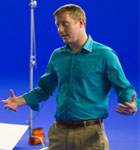Over the course of its 56-year legacy, Schnabel Engineering has made a business of wrestling control of the Earth. The 300-person employee-owned firm specializes in solving the toughest problems the environment can throw at it. With 19 offices nationwide, Schnabel is well positioned to handle a variety of projects. The firm levies its expertise in a variety of ways and has made a name for itself in both dam and tunnel engineering. Schnabel president Raymond DeStephen took time out of his busy schedule to chat with Profile about the firm’s latest endeavors.
Schnabel seems adept at large-scale projects. What have you been tackling recently?
We just recently completed a replacement dam for the City of Greensboro, North Carolina, whose existing dam, representing 80 percent of [the city’s] water supply, was crumbling due to concrete deterioration. On a project in Greenville, South Carolina, we injected molasses into the ground to make chromium contamination less mobile, reducing the threat to groundwater. And in Washington, DC, we redesigned the sinking plaza surrounding the Jefferson Memorial.
How did Schnabel establish such a niche?
It was partly a matter of circumstance and partly understanding the needs of our clients. For example, from our beginnings as geotechnical engineers in the Washington Metro Area, we eventually tapped into the needs of the Federal Government, and now assist the State Department on projects around the world, having performed work on six continents and over 70 countries. Sensing the importance of future water-supply demand, we made strategic hires and acquisitions starting in 1994, which led to us becoming one of the premier dam designers in the US. By virtue of a long history of projects involving the subsurface, and relationships built over the years, it seemed natural to acquire a tunnel-design firm, which we did in 2005.
Can you describe your day-to-day?
As president … I am in charge of the geopractice, with major markets in transportation, federal services, infrastructure, and vertical construction. It is my responsibility to ensure that the firm is providing exceptional service and quality to clients, so that they become part of our repeat business, which lends itself to attaining a steady revenue stream. On the other side of the coin is the consideration of risk, so as not to incur unnecessary liabilities. Considerable time is also spent understanding the markets we are in, and how to position ourselves in new markets.
What’s on the horizon for Schnabel?
Within the next five years, we anticipate [having a staff of] over 400 people and growing all of our service areas. We anticipate generating a larger footprint within the continental United States through strategic hires and acquisitions. Our expectation is that we will do much more work overseas as we partner with our global clients to do more than just the federal-related work we enjoy today.
How does being employee-owned work out for the company?
We have been an employee-owned company for many years, and in 2011 became a 100 percent ESOP. This has worked exceedingly well for us, as it fits with our culture, which can be best described as a “family-like” business. Employees have always felt ownership, and although that doesn’t make people work harder, it definitely gives them a pride of ownership and a true interest in the success of the company.
